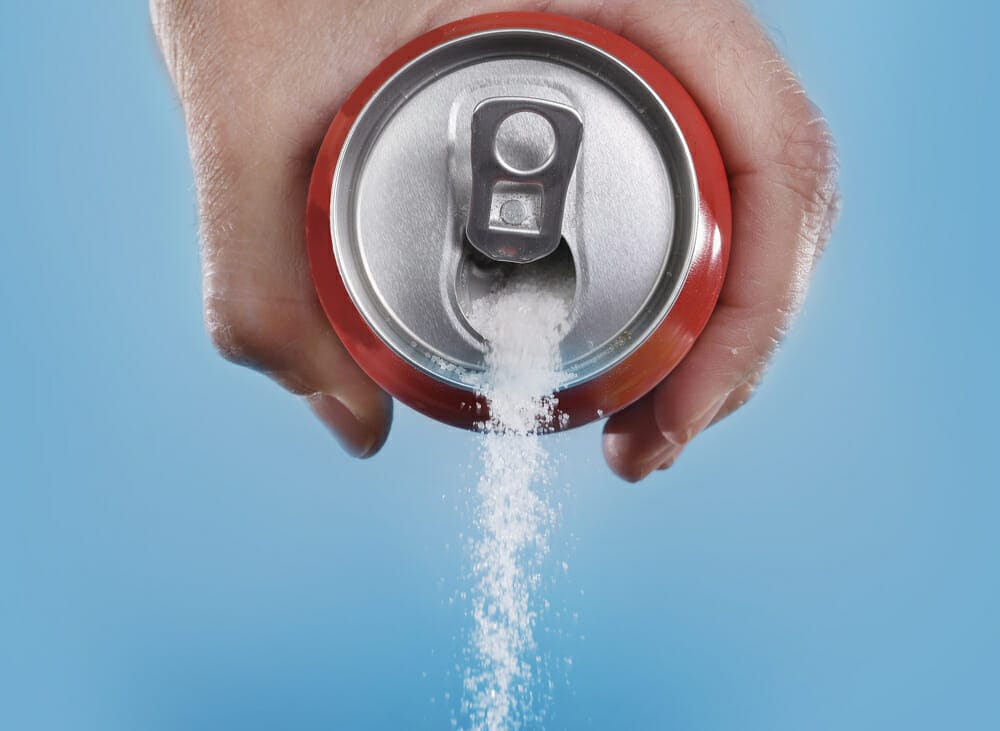A sugar detox is a method of cleansing and renewing the body by radically reducing sugar consumption. When consumed in significant quantities, sugar dismantles a smoothly functioning hormone balance, promotes the accumulation of toxins, causes rapid fluctuations in energy levels, and even contributes to serious diseases. Eating sugar in excess is a very common phenomenon, as it is added to most of the products that are on our menus every day. Learn how to do a sugar detox and improve your body!
Table of contents
What is a sugar detox?
There is a reason why for several years doctors and nutritionists have been sounding the alarm about the excessive consumption of sugar in society. According to WHO, one should consume more than 12 teaspoons of sugar per day, meanwhile we consume much more. Of course, it’s not just traditional white sugar, but also all products that have sugar in their composition. According to statistics, we consume about 20 teaspoons of sugar per day. And annually we consume about 45 kg of sugar, which is a dozen kg more than even a decade ago.

Sugar is contained in almost all types of food and in most beverages. Most of it is, of course, in candy and colored sodas, but not inconsiderable amounts can also be found in: ready meals, salty snacks, white bread and pastries, sauces, ketchup, honey, jams, fruit yogurts, ready-made breakfast cereals and muesli.
Over-saturation with sugar is neither good for your health nor your figure. Sugar is a major cause of overweight and obesity, and one important factor in accelerated aging and the development of diseases. Continuous reaching for sugar products also negatively affects brain function. Metabolism abnormalities and pH disturbances in the body, associated with excess consumption of simple carbohydrates, also contribute to the appearance of skin problems in many people.
Asugar detox is a proven way, recommended by many, to comprehensively improve the condition of the body, from improving the work of organs and systems, to reducing unnecessary body fat, to improving the texture of the skin.
Since a sugar detox involves getting rid of sugar from the diet and replacing it with other foods, it is quite a challenge for many people. If you’ve been following a sugar-based diet for years, it’s hard to even imagine switching to a completelya completely different dietary regimen, in which there is no place for sweets, fast food and instant-to-cook half-finished products.
However, conducting a sugar detox is not as difficult an undertaking as it might seem. All we need to do is to make dietary modifications gradually, rather than abruptly, and to use appropriate sugar substitutes.
Check: Fat Burners Ranking
How does sugar affect the brain?

Sugar affects neurotransmitters in the brain, and thus affects mood, perceived energy levels and mental performance. Acting on the so-called reward system, it raises levels of dopamine, endorphin and serotonin – neurotransmitters responsible for feelings of pleasure and happiness. Eating it makes us gain a better mood, feel contentment and joy.
Sugar is also called brain food for a reason. It provides it with a rapidly released source of energy, has an invigorating effect and facilitates information processing. It is also helpful in case of increased exertion of the body – it reduces fatigue and helps “recharge the batteries”. This is a big advantage of sugar, but it is one thing to provide the body with low doses of simple carbohydrates in order to keep the body working properly, and another to consume sugars in far too large quantities and regulate one’s emotions with them.
Sugar addiction

Consumed sugar acts on the pleasure center, which is why it’s so hard to stop eating one bite or piece, instead we crave more, and more. While the rash of positive emotions after consuming sugar is in itself a positive phenomenon, it can sometimes be dangerous. An occasional two pieces of chocolate eaten to improve the mood has not yet harmed anyone, but when we start consuming sugar uncontrollably to get rid of bad emotional states, we may have a problem.
Too much use of sugar can lead to addiction. An addict uses it to “get” negative emotions out of his head, regulate his mood, level out irritability and stress. In doing so, he or she suffers the whole gamut of consequences that any addiction brings, from remorse, general mental deterioration and a sense of lack of control, to long-term negative consequences in the form of disease.
As we reach for sugar more and more often and with increasing intensity to boost our mood or kill stress, our body begins to get used to it and demand larger and larger doses for the same effect. Like alcohol, drugs or cigarettes, sugar is physically and mentally addictive.
Why is it important to reduce sugar consumption?
Long-term abuse of sugar negatively affects health and body condition. To make matters worse, the negative effects of consuming excessive amounts of sugar can only occur years later.
When we consume a meal laden with simple sugars, blood glucose levels rise sharply, followed by a spike in insulin to balance it out. Glucose levels then drop, and excess sugars are stored in fat tissue. Continuous fluctuations in blood sugar levels result in the development of insulin resistance and then diabetes, and fuel the process of weight gain. However, glycemic problems and obesity are not the only results of sugar abuse.
Negative effects of consuming large amounts of sugar include:
- tooth decay,
- overweight,
- obesity,
- hypertension,
- cardiovascular disorders, accelerated progression of atherosclerosis,
- insulin resistance,
- diabetes,
- sudden drops in energy, attacks of daytime sleepiness,
- constant fatigue,
- hyperactivity (especially in children),
- mood swings,
- concentration problems,
- acidification of the body,
- disturbed metabolism,
- disruption of the body’s self-cleaning process,
- lowering of the body’s immunity, greater susceptibility to infections and diseases,
- skin ailments (e.g. eczema, gray and tired complexion, bruises under the eyes, seborrhea, excessive dryness of the skin, faster aging of the skin).
Wanting to take care of the health, figure and appearance of the skin, it is worth opting for a sugar detox involving a significant reduction in the supply of simple carbohydrates in the diet.
At the same time, it is important to remember that not all simple sugars are equally unfavorable and not all of them should be avoided like fire. Fruits and other products that contain dietary fiber in addition to simple sugars are better tolerated and more efficiently absorbed by the body. Much worse for the body are products that contain large amounts of artificially added sugar and products that are saturated with simple sugars and at the same time lacking in fiber.
Advantages of sugar detox:
- normalization of glucose-insulin metabolism,
- reducing the risk of many diseases of civilization,
- slimming of the figure,
- normalizing energy levels, reducing attacks of fatigue and lethargy,
- more efficient cleansing of the body from toxins,
- better metabolism,
- better sleep,
- slower aging of the body,
- better skin and teeth condition.
Importantly for people who find it hard to lose weight – firmly limiting sugars in the diet while increasing the level of physical activity is one of the most effective methods for quickly shedding weight.
Appetite blocker and fat burner in one: NuviaLab Keto
How to wean off sugar? How to do a sugar detox?

To effectively eliminate sugar in your diet, it’s best to start by gradually cutting back on sugary foods to prepare your body for your new eating style. A small note of caution, we should never exclude simple sugars completely, as a small amount is necessary for the body to function properly. However, it is worth using their natural sources, such as fruits, porridge, rice, cereals. Also, honey consumed in small amounts should not harm anyone.
How to limit sugar? The best way is to do it in 6 simple steps:
- Gradually reduce the amount of sugars you eat and the frequency with which you eat them. Initially, try to limit eating sugar products to 1-2 times a day and in reduced portions (e.g., instead of 4 cookies, 2 cookies, instead of a whole bar, half a bar, etc.), then try eating them every 2 days in even smaller amounts, and so on.
- Use sugar substitutes, especially at the beginning of a sugar detox, when your body is still heavily accustomed to the sweet taste. Healthy sweeteners such as xylitol and erythrol are an excellent option. Plant-based products characterized by a very sweet taste, but which do not contain simple sugars, will also work. These include stevia and licorice.
- Use dietary supplements containing chromium, HCA and extracts that reduce cravings for sweet. They help maintain a low-sugar diet while accelerating the loss of excess weight.
- Drink plenty of water and green tea, and use herbs and herbal preparations that stimulate the removal of toxins from the body, improve metabolism and normalize blood glucose levels (e.g. white mulberry, nettle, bladderwrack).
- In moments of craving for something sweet, reach for low-sugar fruits (e.g. grapefruit, strawberries, apples, currants, blueberries, raspberries) or small sweet snacks high in fiber (e.g. raisins, dried prunes, dried apricots, homemade oatmeal cookies and sugar-free cereal bars, banana chips, pistachios).
- Don’t follow the rule of radically breaking up with all sweets, only reject store-bought ones that are saturated with sugars. Start making sweet snacks with your own hands, without added sugar. Such dietary desserts as fruit mousses, berry puddings, baked pears with nuts, bean brownie, peanut butter and flaxseed balls, coconut pralines made from millet groats and others can be truly delectable.
Sugar-free diet, or what can we eat on a sugar detox, and what should we avoid?

In a sugar-free diet, we throw out of the menu all processed foods, ready-made meals, ready-made sauces, sweets and colored drinks. In general, we avoid foods with high GI (glycemic index). They lead to sharp spikes in blood glucose and promote the development of diabetes. However, if we want to thoroughly improve the condition of the body and figure, sugar restriction alone is not enough. It should go hand in hand with the introduction of new healthy eating habits on a permanent basis.
To balance the lack of sugar, it is worth reaching for products rich in complex carbohydrates, including fruits, vegetables, oatmeal, bran, whole-grain bread, brown rice, coarse groats. They will be an effective energy source for us, and will provide the body with a whole range of gains. Unlike simple carbohydrates, complex carbohydrates do not cause sudden spikes in blood sugar levels and disrupt metabolic processes, nor do they fatten.
At the same time, it is worth increasing the amount of grains, nuts, as well as sea fish eaten. These products contain healthy types of fats (unsaturated fatty acids), provide large amounts of energy, and are extremely beneficial for the brain, heart, cardiovascular system and immune system.
In a sugar-free diet, it is also worthwhile to frequently reach for dairy products, especially lean ones (such as cottage cheese, yogurt, kefir, buttermilk). They perfectly satisfy hunger and curb the craving for sweet flavors.
Check: Ranking of Weight Loss Pills
Sources:
- https://www.webmd.com/diet/ss/slideshow-effects-cut-added-sugar
- https://www.healthline.com/health/sugar-detox-symptoms
- https://www.healthline.com/health-news/quitting-junk-food-produces-similar-withdrawals-as-drug-addiction
- https://www.webmd.com/diabetes/ss/slideshow-diabetes-too-much-sugar

